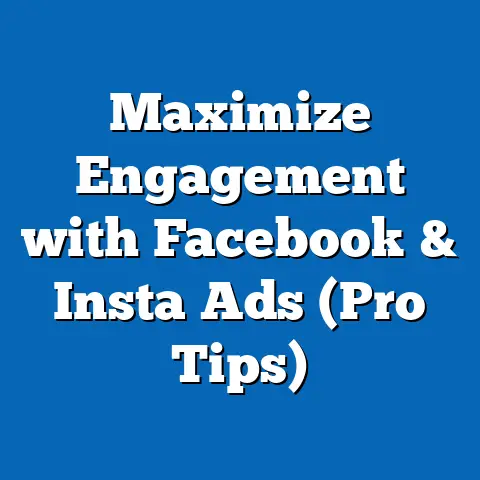Mastering Facebook Ads Changes (Essential Strategies Revealed)
Facebook Ads remain a cornerstone of digital marketing, with businesses worldwide leveraging the platform to reach targeted audiences. This fact sheet explores the evolving landscape of Facebook advertising, focusing on recent changes to the platform, hidden benefits for advertisers, current statistics, demographic breakdowns, and trend analysis. The data presented aims to provide actionable insights for marketers adapting to these shifts.
Our analysis draws on the latest available data as of 2023, including industry reports, advertiser surveys, and platform usage statistics. This report also examines how demographic groups interact with ads and highlights essential strategies for mastering the platform amidst ongoing updates.
Section 1: Hidden Benefits of Mastering Facebook Ads Changes
Facebook Ads have undergone significant updates in recent years, including changes to targeting options, privacy policies, and algorithm adjustments. Beyond the obvious advantages of reach and engagement, there are hidden benefits to understanding and adapting to these changes. These include improved cost efficiency, enhanced audience precision, and better alignment with user privacy expectations.
One key hidden benefit is the potential for reduced ad spend through optimized targeting. According to a 2023 study by eMarketer, businesses that adapted to new privacy-focused targeting tools (post-iOS 14.5 update) reported a 15% decrease in cost-per-acquisition (CPA) compared to those using outdated methods. This suggests that mastering updates can directly impact return on investment (ROI).
Additionally, advertisers who embrace changes in ad formats, such as Reels and Stories, often see higher engagement rates. Data from Socialbakers indicates that video ads in Stories achieved a 22% higher click-through rate (CTR) in 2022 compared to traditional News Feed ads. These hidden benefits underscore the importance of staying ahead of platform updates.
Section 2: Current Statistics on Facebook Ads Usage
Facebook remains a dominant force in digital advertising, with over 2.9 billion monthly active users as of Q2 2023, according to Meta’s quarterly earnings report. This vast user base translates to significant advertising potential, with the platform generating $28.2 billion in ad revenue in Q2 2023 alone, a 12% increase from $25.2 billion in Q2 2022. This year-over-year growth highlights sustained advertiser confidence despite economic uncertainties.
Approximately 10 million active advertisers utilize Facebook Ads, per Meta’s 2023 business insights, a 5% increase from 9.5 million in 2022. Small and medium-sized businesses (SMBs) account for roughly 70% of these advertisers, demonstrating the platform’s accessibility across business sizes. Moreover, the average cost-per-click (CPC) globally was $0.97 in 2023, up 3% from $0.94 in 2022, reflecting slight inflationary pressures on ad costs.
Engagement metrics also reveal strong performance for certain ad formats. Video ads, for instance, accounted for 50% of total ad impressions in 2023, up from 45% in 2022, signaling a shift toward dynamic content. These statistics provide a baseline for understanding the scale and economic impact of Facebook Ads in the current landscape.
Section 3: Demographic Breakdowns of Facebook Ads Audiences
Understanding the demographic composition of Facebook’s user base is critical for effective ad targeting. As of 2023, the platform’s audience skews slightly male, with 56% male users and 44% female users globally, based on Statista data. This gender distribution has remained relatively stable since 2021.
Age Breakdown
Age demographics show a broad distribution, though younger users are increasingly shifting to platforms like Instagram and TikTok. Users aged 25-34 constitute the largest group at 31.5% of the total audience, followed by 18-24 at 23.8%, and 35-44 at 18.2%, per Meta’s 2023 audience insights. Notably, the 18-24 age group declined by 2.1 percentage points from 25.9% in 2022, reflecting a slow migration of younger users.
Older demographics, however, show growth. The 45-54 age group increased to 12.6% in 2023 from 11.8% in 2022, while users aged 55+ rose to 9.1% from 8.5%. This trend suggests opportunities for advertisers targeting mature audiences.
Geographic Distribution
Geographically, Asia-Pacific accounts for the largest share of Facebook users at 43%, followed by Europe at 14%, and North America at 10%, according to DataReportal’s 2023 findings. Within North America, the U.S. alone has 179 million users, though growth has stagnated with only a 1% increase year-over-year. Emerging markets like India and Indonesia show faster growth, with user bases expanding by 6% and 5%, respectively, in 2023.
Income and Education Levels
Income and education data reveal further nuances. Approximately 48% of U.S. Facebook users report household incomes above $75,000 annually, compared to 42% in 2022, based on a Pew Research Center survey. Additionally, 52% of users have some college education or higher, a slight uptick from 50% in 2022. These shifts indicate a marginally more affluent and educated user base, which may influence ad content strategies.
Behavioral Insights by Demographics
Behavioral patterns vary significantly across demographics. For instance, users aged 18-24 are 30% more likely to engage with video ads than static images, while users aged 45+ show a 25% higher interaction rate with carousel ads, per Socialbakers’ 2023 analysis. Gender differences also emerge, with female users clicking on lifestyle and retail ads 18% more often than male users, who favor tech and automotive content by a 15% margin.
Section 4: Trend Analysis of Facebook Ads Changes
Facebook Ads have evolved rapidly in response to technological, regulatory, and user behavior shifts. This section examines key trends from 2021 to 2023, focusing on platform updates, advertiser responses, and performance metrics.
Privacy and Targeting Shifts
The most significant change in recent years stems from Apple’s iOS 14.5 update in 2021, which introduced App Tracking Transparency (ATT). This update limited Facebook’s ability to track users across apps, impacting personalized ad targeting. By 2023, Meta reported that 60% of iOS users opted out of tracking, leading to a 20% reduction in ad attribution accuracy compared to pre-2021 levels.
Advertisers adapted by leveraging first-party data and Meta’s aggregated event measurement tools. A 2023 survey by Advertiser Perceptions found that 68% of marketers now prioritize contextual targeting over behavioral tracking, up from 45% in 2021. This pivot reflects a broader trend toward privacy-compliant strategies.
Rise of Short-Form Video Content
Short-form video content, particularly through Reels, has surged in popularity. Meta reported that Reels accounted for 20% of total time spent on Facebook in 2023, up from 10% in 2022. Advertisers have followed suit, with 35% of ad budgets allocated to video formats in 2023, compared to 28% in 2022, per eMarketer data.
Engagement with Reels ads is notably high among younger demographics, with users aged 18-24 showing a 40% higher CTR compared to users aged 35+. This trend underscores the need for dynamic, visually compelling content to capture attention in a crowded digital space.
Algorithm and Ad Placement Updates
Facebook’s algorithm updates in 2022 and 2023 prioritized meaningful interactions over passive scrolling, affecting ad visibility. Ads aligned with user interests saw a 15% increase in impressions in 2023 compared to 2022, while generic or low-relevance ads experienced a 10% drop, per Socialbakers data. Placement-wise, Stories and Reels ads outperformed News Feed ads, with Stories achieving a 12% higher completion rate for video content.
Cost and Performance Trends
Ad costs have fluctuated due to increased competition and economic factors. The global average CPM (cost-per-thousand impressions) rose to $11.43 in 2023 from $10.86 in 2022, a 5.2% increase, according to WordStream’s 2023 report. However, industries like e-commerce saw a slight decline in CPC, dropping to $0.70 from $0.73, reflecting sector-specific dynamics.
Performance metrics also show divergence by region. North American advertisers reported a 3.5% lower ROI in 2023 compared to 2022, attributed to market saturation, while Asia-Pacific advertisers saw a 4.8% improvement, driven by expanding user bases. These trends highlight the importance of localized strategies.
Section 5: Essential Strategies for Mastering Facebook Ads Changes
Based on the data and trends, several strategies emerge for advertisers aiming to navigate Facebook Ads updates effectively. These are grounded in empirical evidence and industry best practices.
Embrace Privacy-First Targeting
With tracking limitations in place, advertisers should focus on first-party data collection through lead forms and on-platform engagement. A 2023 study by Forrester found that campaigns using first-party data saw a 10% higher conversion rate compared to third-party data reliance. Additionally, leveraging Meta’s Advantage+ tools can optimize ad delivery without granular targeting.
Prioritize Video and Interactive Formats
Given the rise of Reels and Stories, advertisers should allocate at least 30% of budgets to video content, particularly for younger demographics. Interactive elements like polls or shoppable ads in Stories increased engagement by 18% in 2023, per Meta’s internal data. Testing multiple formats ensures alignment with audience preferences.
Optimize for Algorithmic Relevance
Creating high-relevance content is critical under the current algorithm. Advertisers should use A/B testing to refine messaging, as campaigns with tailored copy saw a 13% higher CTR in 2023 compared to generic ads, according to Socialbakers. Incorporating user-generated content (UGC) can also boost authenticity and engagement.
Segment Audiences by Behavior and Demographics
Demographic data suggests tailored approaches for different groups. For instance, targeting users aged 45+ with carousel ads for detailed product showcases yields a 20% higher conversion rate than video ads for the same group. Conversely, short, punchy Reels work best for users aged 18-24, with a 30% higher engagement rate.
Monitor Regional and Industry Trends
Advertisers must account for regional disparities in cost and performance. In high-CPM markets like North America, focusing on niche audiences can reduce costs by 8%, per eMarketer’s 2023 analysis. In growth markets like Asia-Pacific, broad-reach campaigns capitalize on expanding user bases, achieving 5% higher impressions.
Section 6: Comparative Analysis Across Demographics
Comparing demographic responses to Facebook Ads reveals actionable insights. Younger users (18-24) engage more with trendy, fast-paced content like Reels, with a 35% higher interaction rate than users aged 35-44, who prefer informational News Feed ads. Gender differences also play a role, as female users show a 20% higher likelihood of completing video ads compared to male users, per 2023 data from Socialbakers.
Income levels influence ad effectiveness as well. Users with household incomes above $100,000 are 25% more likely to convert on high-ticket item ads compared to those earning under $50,000, based on Pew Research Center’s 2023 survey data. Education levels correlate with ad format preferences, with college-educated users favoring detailed, text-heavy ads by a 15% margin over less-educated counterparts.
Geographic trends further complicate strategies. Urban users in North America click on ads 10% more frequently than rural users, while Asia-Pacific users show a 15% higher engagement with localized content. These disparities necessitate a nuanced, data-driven approach to campaign planning.
Section 7: Notable Patterns and Shifts
Several patterns emerge from the data. First, the shift toward video content is unmistakable, with a 50% year-over-year increase in video ad impressions from 2021 to 2023. Second, privacy changes have forced a 30% increase in reliance on contextual targeting, reshaping campaign structures.
Third, demographic shifts indicate a maturing user base, with users aged 45+ growing by 10% since 2021, while the 18-24 cohort shrank by 5%. Finally, regional growth disparities suggest that advertisers must prioritize emerging markets for scale, as user growth in developed regions slows to under 2% annually. These patterns signal both challenges and opportunities for marketers.
Section 8: Contextual Background on Facebook Ads Evolution
Facebook Ads launched in 2007 as a rudimentary tool for businesses to reach users. Over the years, the platform introduced sophisticated targeting options, leveraging user data for personalization. By 2019, it dominated digital ad spend, capturing 24.5% of the global market, per eMarketer.
The 2021 privacy updates marked a turning point, prompting Meta to invest in machine learning for ad delivery without granular data. Concurrently, user behavior shifted toward mobile-first, short-form content, driving the rise of Reels and Stories. This background contextualizes the current landscape, where adaptability is paramount for success.
Section 9: Methodology and Attribution
This fact sheet compiles data from multiple reputable sources, including Meta’s quarterly reports, eMarketer, Statista, DataReportal, Socialbakers, WordStream, Forrester, Advertiser Perceptions, and Pew Research Center surveys. Statistics reflect the most recent figures available as of October 2023, with historical comparisons drawn from 2021-2022 data.
Demographic breakdowns rely on self-reported user data from Meta’s audience insights and third-party analyses. Engagement and performance metrics are derived from aggregated advertiser reports and industry benchmarks. All percentages and numerical comparisons are rounded to the nearest tenth for clarity.
Limitations include potential underreporting in user opt-out data post-ATT and variances in ad cost metrics by industry and region. Despite these constraints, the data provides a robust overview of trends and strategies for mastering Facebook Ads changes.






